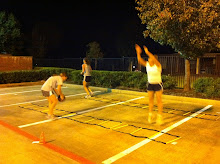The single most important thing the monitoring of % body fat will do is determine changes in muscle tissue over time. By knowing % body fat, the % of muscle, bone, organs, etc. can also be determined. For example, if a person has 20% body fat and weighs 135 lbs., then 27 lbs. of this is fat. Everything else, which is referred to as "lean mass", is 80% of their weight or 108 pounds. Of this lean mass, the component that can change the most is muscle tissue. So if a person monitors their change in % body fat and weight, they can also determine their change in muscle tissue. Muscle tissue can increase or decrease depending on a person's DIET, activities, exercise, and lifestyle.
There are several interesting things about body composition and muscle tissue that recent research has shown. One major study has shown that the typical American loses muscle tissue and gains fat steadily from about age 20 on. The study shows that even people of standard weight who maintain their same weight as they grow older, still gain fat and lose muscle tissue. This deterioration doesn't have to happen though. It is due to the typical American lifestyle. It has been shown that those who exercise regularly, along with proper diet, do not lose muscle tissue or gain fat. In fact, even at age 50 and above, it is possible to build muscle tissue back up and regain correct balance between muscle, fat, and weight. All that is necessary is the proper exercise and diet program. But remember that the deterioration starts early. Even by the age of 25, the typical American has lost 3% of their total body weight in muscle tissue and replaced it with corresponding increase in % body fat. And this is just for those who maintain their correct weight! For those whose weight has increased, the situation is worse because almost all the weight increase is fat. If a person monitors their % body fat regularly, they can detect muscle loss early on and take corrective action before serious changes take place.
Another very important use of % body fat measurements is to monitor the effect of diet and/or exercise on muscle tissue and fat. For example, research has shown that when a person goes on a typical fad diet, with little exercise, they lose as much or more muscle tissue than fat. Scales will not tell a person this is happening, but measuring % body fat regularly will. Then if this person goes off the diet and gains the weight back, they gain more fat and less muscle tissue than they lost. The result is that they have more fat and less muscle tissue than before the down-up cycle and worse off than before the diet. So again, measuring % body fat will show this where as scales won't.
So then, as we've discussed before, the way to properly reduce body fat is through regular exercise combined with a proper well-balanced diet. Doing this, it's possible for a person to actually gain muscle tissue while losing fat. Measuring % body fat regularly will determine the effectiveness of the exercise-diet program being used.
We've got the exercise part down with the boot camp and extra cardio or strength training that you're doing on your own (because I know you're doing some other stuff on your own, right?!?) The biggest factor to losing the fat though (one which I can't control, but you can) is your DIET!! Did you catch all my hints above regarding its importance? Go back and look at those old emails I sent out early on (What?! You don't keep everything from me?!) or older blog posts to refresh your memory about some important nutrition tips. Nutrition education is on the horizon. Another thing I' like to have on the blog is a nutrition tip of the week. And I'm hoping to have some links to some good ideas/recipes as well. All these plans...but no time to make them happen yet! First I must make it to May 31... Thanks for ya'll's patience.
Have a great weekend! See you next week!




















No comments:
Post a Comment